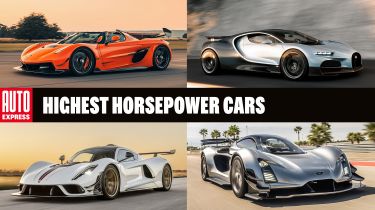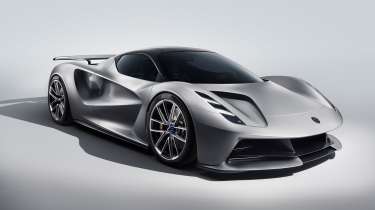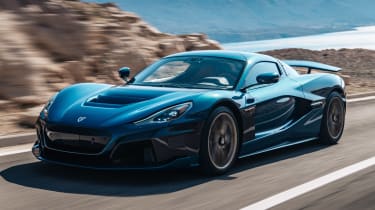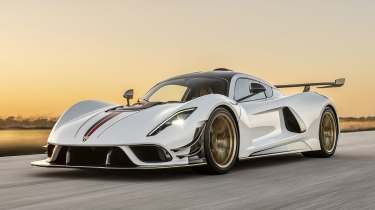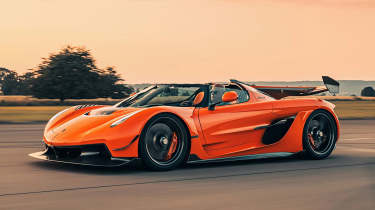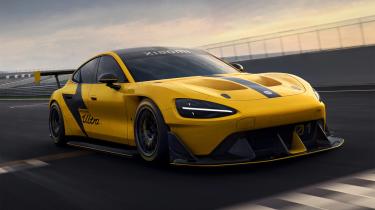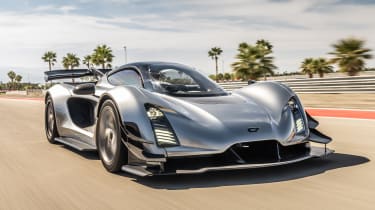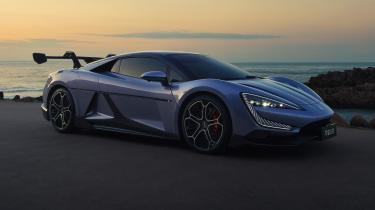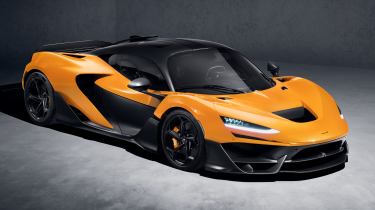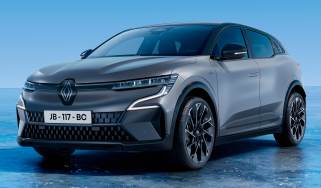Highest horsepower cars 2025: The most powerful cars you can buy
It seems like a while since the 618bhp McLaren F1 was setting records; today’s hypercars make up to 2,000bhp
Things have gone just a little bit mad. We live in a world of 400-horsepower family cars, 700-horsepower saloons, and if you’re creating a supercar, don’t even bother unless it has a four-figure power output. Where once the world’s most exotic and powerful cars got by on perhaps 500, or 600bhp – the original McLaren F1 developed 618bhp – today it’s not unusual to see two or even three times that number. The world’s most powerful cars are completely off the charts of what we’d have thought possible a few years ago.
One factor driving this explosion in power has been the ease of extracting enormous numbers from electric motors, though you might be surprised how many of the world’s most powerful cars still use internal combustion. Even if petrol machines don’t top the highest horsepower list, you can be sure they’re the most exciting.
Now for some housekeeping: some of the world’s most powerful cars may be missing from this list, but we’ve tried to keep it to models that are nominally available right now, with either open order books, or cars still rolling from the factory gates. We’ve excluded cars that have already ended production (so no Bugatti Chiron Super Sport and the like), as well as pie-in-the-sky projects with little certainty of ever turning a wheel. And just like the world’s fastest and most accelerative cars, it’s an ever-evolving list…
1. Lotus Evija: 2,012bhp
The Evija is not a light Lotus, coming in at a full 1,887kg. That’s 2.6 original Elises, 2.9 classic Elans, or 4.2 series one Lotus 7s. It is a very, very powerful one though, with 2,012bhp from its four electric motors – each motor equivalent to the output of 4.2 of the Elise’s Rover engines, five Elan 1500s, or fourteen Lotus Seven Series 1s.
Lotus owners and enthusiasts would rightly point out that power isn’t the point of a Lotus, so the Evija still has a lot to prove. Not least to customers, who’ve had to wait their sweet time for deliveries to begin – something that started only in late 2024, a full five years after the car was unveiled, thanks in no small part to the pandemic. Will the power, and the driving experience, make up for that?
2. Rimac Nevera: 1,888bhp
Here’s what Mate Rimac did before his company took the reins at Bugatti and created the Tourbillon. The Nevera arrived in 2022, following on from the already massively potent 1,224bhp Concept One, with 1,888bhp at its disposal from a motor at each wheel, allowing not just enormous performance (0-62mph in 1.74 seconds, 256mph) but also true torque vectoring for remarkably agile handling.
Finding buyers though has been tricky, with Mate Rimac himself suggesting in 2024 that there’s not really a market for high-end, all-electric hypercars, however powerful they are. No doubt slow sales of the Nevera (and its differently-styled twin, the Pininfarina Battista) influenced the direction of the V16-engined Bugatti Tourbillon. Even so, the Nevera has been a good shop window for Rimac, which has contributed components and technical expertise to several major car manufacturers for their own EVs.
3. Hennessey Venom F5: 1,817bhp
Hennessey seemingly exists to give much larger supercar and hypercar makers a hard time. No sooner do the likes of Bugatti attempt a record-breaking acceleration or top speed run, you can just about guarantee Hennessey will be there a year or so later to snatch the record back.
The Venom F5 is Hennessey’s most recent creation, taking its name from the biggest, deadliest rating on the scale used to measure tornadoes, and created with the goal of breaching the 500km/h mark, or 311mph. That’s a fair way above the current, officially-recognised two-way speed record of nearly 278mph held by Koenigsegg with the Agera RS, but consider that Bugatti achieved over 490km/h (around 305mph) with the Chiron Super Sport 300+ in 2019, albeit in a one-way run, and Hennessey’s target is clear. If the F5 attempts the record, it’ll do so with the most powerful combustion engine on this list: a 1,817bhp 6.6-litre twin-turbocharged V8, and power going to its rear wheels alone.
4. Bugatti Tourbillon: 1,775bhp
The Bugatti Tourbillon isn’t the most powerful car here, but it’s surely one of the most exciting. Where electric power is now the default for making big numbers, the Tourbillon has the makings of a true engineering masterpiece, courtesy of its Cosworth-developed 8.3-litre V16 engine. From what we’ve heard so far, it’s a truly blue-blooded sound, and one with which no manner of digitally-assisted EVs can compete.
There is some electrification, with a pair of front motors and one at the rear, but their combined 789bhp contribution still plays second-fiddle to the V16’s 986bhp at 9,000rpm. Together, they deliver a claimed 0-62mph time of 2.0 seconds, and 277mph flat out. The Tourbillon is about more than numbers though: where its electric rivals get digital instruments no more exotic than you’d find in a £20k supermini, the Bugatti’s intricate gauges are as elegant as a Swiss watch.
5. SSC Tuatara: 1,750bhp
Controversy over a top speed record attempt has unfortunately cast a shadow over the SSC Tuatara, which is otherwise one of the most dramatic and highly-developed hypercars around, and has pedigree in its styling too: it’s the work of Jason Castriota, who designed the last Maserati GranTurismo, the Ferrari 599, and the stunning Enzo-based Ferrari P4/5 for Jim Glickenhaus in 2006.
While the Tuatara didn’t achieve its original 316mph two-way claim in 2020, a verified 295mph run in 2022 still puts it among the world’s fastest cars. Slick aero helps (a claimed drag coefficient of 0.279), but the car’s 5.9-litre, twin-turbocharged, flat-plane crank V8 also plays a rather large part, thanks to its 1,750bhp output. SSC even offers a 2,212bhp option, which would top this list, but it’s unclear whether any of these versions actually exist in the real world.
6. Koenigsegg Jesko: 1,578bhp
Koenigsegg has been a regular on ‘most powerful car’ lists since the CC8S of 2002, which made 665bhp. Given that you can get that kind of output from a saloon these days though, the brand’s most recent car, the Jesko, needs a little more to impress: 1,578bhp from a 5.1-litre twin-turbocharged V8 of Koenigsegg’s own design. The car’s nine-speed ‘Light Speed Transmission’ is also designed and built in-house.
The Jesko (named after founder Christian von Koenigsegg’s father) is still in production, though the 125-car allocation sold out almost immediately, split between a high-downforce Attack model, and the sleek Absolut – which uses its power and aero to good effect, if a theoretical top speed of as much as 350mph is to be believed.
7. Xiaomi SU7 Ultra: 1,526bhp
One of these is not like the others. Most of the cars here are low-slung, dramatically-styled hypercars, straight from the pages of comic-books and out of futuristic videogames. Yet the SU7 Ultra, from Chinese manufacturer Xiaomi Auto (subsidiary of one of the world’s biggest smartphone manufacturers), looks a bit like the BYD Seal you can buy in UK showrooms.
Only the Seal doesn’t have an ‘Ultra’ variant with triple electric motors and 1,526bhp at its disposal, putting it among the world’s most powerful production cars. Extra carbonfibre aerodynamic addenda helps keep the SU7 stuck to the ground (important, given the basic version makes 295bhp – surely giving the SU7 the greatest range of power outputs of any car in history), while 900-volt batteries are used to deliver quick, enormous hits of power to supply the motors. 0-62mph takes under two seconds, and top speed is well over 200mph.
8. Czinger 21C: 1,332bhp
From a mind-boggling saloon car to another more traditional hypercar, though the Czinger 21C’s two-seat tandem cockpit is a little different from the norm, and the narrow space means even more of the car’s bodywork can be dedicated to aero.
One thing that makes the 21C particularly special is that much of the car’s output comes from a relatively tiny 2.88-litre twin-turbocharged V8, though there are a pair of electric motors to go with it, generating 1,332bhp at 11,500rpm, and four-wheel drive. While we’ve not seen any top-speed runs yet, the 21C did make a name for itself at 2024’s Goodwood Festival of Speed, with a 48.82-second run that makes it the quickest production car ever to go up the hill (though it’s still around ten seconds slower than the tiny McMurtry Spéirling).
9. Yangwang U9: 1,287bhp
You might not have heard of Yangwang, but you’ll have heard of the company that builds it: BYD. Yep, the company responsible for the Atto 3, Seal, and other sensible electric family cars also makes a 1,287bhp super-coupe, styled under the direction of Wolfgang Egger – better known for leading the Alfa Romeo 8C project.
Being Chinese, it’s no surprise that the Yangwang U9 uses electric power, in this case four motors supplied by an 80kWh battery pack and running on 800-volt architecture. The four-motor setup allows for torque vectoring, while active suspension can even make the car jump – though is perhaps more useful for allowing the low-slung machine to clear speedbumps and steep ramps. Despite the enormous power output, its 1.68 million Yuan price tag equates to only around £180,000 as of March 2025.
10. McLaren W1: 1,258bhp
Remember that McLaren F1 mentioned at the top? Well the brand's latest hypercar, the McLaren W1, goes into production later this year. With 1,258bhp, it's more than twice as powerful as its forebear, yet it only just sneaks into the top ten. That’s a pretty good example of how this market has changed over the past three decades, though don’t worry about whether the new car is better than its grandfather or not – several W1 buyers will almost certainly already have an F1 (and a P1) in their collection.
The W1 makes its output not from a spine-tingling V12 but a 9,200rpm twin-turbocharged V8. While the layout is familiar, the unit itself is all new, a powertrain McLaren calls the MHP-8 with a 4.0-litre capacity and an electric module similar in concept to those in Formula 1. It powers the rear wheels alone, through an eight-speed dual-clutch gearbox and a computer-controlled differential. Performance? 0-62mph in 2.7 seconds, and around 220mph flat out, though being a McLaren, it’s sure to be just as good, if not better, in the corners.
Now check out our list of the fastest electric cars in the world...

